This post may contain affiliate links. Please read our disclosure policy.
Learn how to make fermented tofu, also called “Chao,” from scratch! This 6-ingredient condiment is cheesy and tangy and can be used to add plenty of flavor to soups, marinades, dipping sauces, and more!

For those unfamiliar with it, chao is a Chinese/Vietnamese condiment made from fermented tofu that has a funky and cheesy taste!
I discovered it several years ago in Vietnam, and since then, I have been using it in so many recipes. Whether it is in soups, marinades, or as a dipping sauce, you can use it in many dishes to add extra flavor, umami, and some cheesiness. I even used it as a base to make vegan cheese slices!
For the little story, I actually learned how to make it from my Vietnamese mother-in-law, who has been making it for decades. She gave me her (not-so) secret recipe, which requires just 6 ingredients and an easy process. To be honest, I was even surprised how simple it is to make it at home!
⭐️ Why You Should Try It
Naturally fermented.
While some fermented recipes call for starters or cultures, this one doesn’t! This means you won’t need any special ingredients to make it. The mold that grows on the tofu is completely natural. The process consists of letting the tofu ferment at room temperature for a couple of days before transferring it to a jar and covering it with brine. Then, all you have to do is wait.
And trust me, the wait is worth it because homemade chao tastes so much better than the jars available in Asian supermarkets!
Cheesy and packed with umami.
After the fermentation process, your tofu will magically transform into creamy cubes packed with a rich cheesiness, plenty of umami, and a touch of tanginess. It will no longer resemble or taste like traditional tofu – instead, it will have an almost aged cheese-like quality.
It keeps for months.
What’s great about chao is that it can be stored in its brine for months, if not years! I personally had a jar that I kept for over a year, and the chao was still perfectly good!
📘 What Is Chao?
Chao (which is its Vietnamese name) is tofu that is fermented for at least 1 month in a brine that consists of water, salt, and usually rice wine. According to some books, the technique of making fermented tofu appeared in 200 BC in China.
Now you may wonder, what does it taste like? Well, it is quite salty, sometimes spicy, and has a very soft texture, almost like a paste that you could compare to blue cheese. When Chao is fermented for a long time, it develops a stronger flavor, which reminds me of a strong Camembert.
🌶 Ingredient Notes
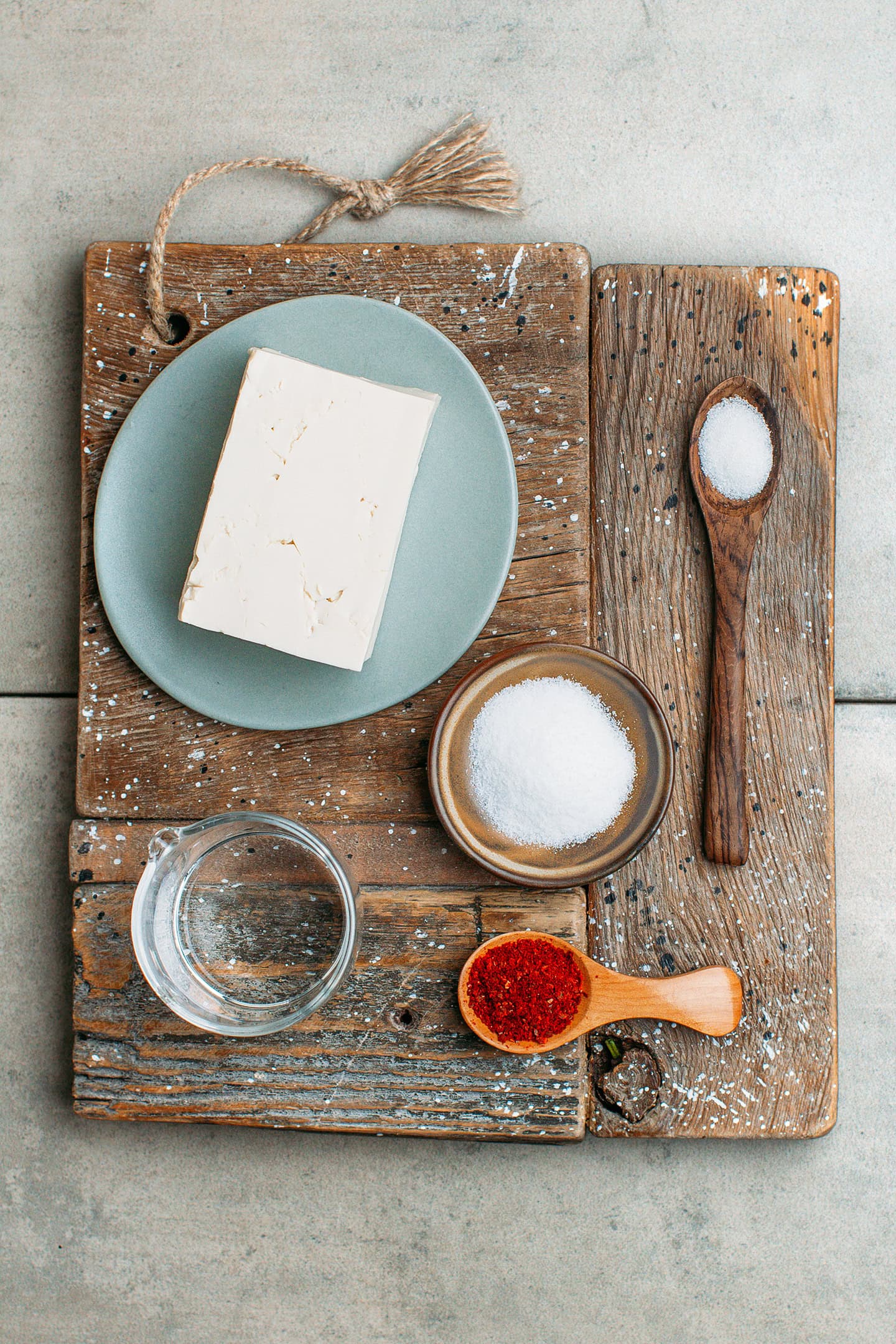
Tofu
Firm tofu makes the base of this recipe. I suggest checking your local Asian supermarket to buy tofu, as it’s often fresher and tastes better compared to brands found in regular supermarkets.
Which type of tofu to use: You should be using firm tofu or extra firm tofu (although I haven’t personally tried with extra firm yet). DO NOT use silken tofu for this recipe – it’s too soft and it would simply crumble into pieces.
Chili flakes (optional)
Two types of chao exist, the white kind and the orange/red one. The latter gets its color from chili flakes or red yeast rice! I personally like to season mine with Korean chili flakes, also known as Gochugaru. This not only adds a touch of spiciness but also gives the chao a vibrant orange hue.
Note: Feel free to omit the chili flakes completely!
🧂 Brine
To prevent the tofu from going bad, you will need to store it in a brine. Allowing the tofu to sit in a brine for a few weeks not only gives it a cheesy aroma but also changes its texture from crumbly to creamy. Here is what you will need to make the brine:
Water
Water makes up the base of the brine. I always use tap water and have never had any issues, but feel free to use bottled water if you prefer.
Salt
Along with alcohol, salt helps preserve the tofu for many months in the brine. Please do not try to decrease the amount of salt – doing this could cause your tofu to spoil quickly.
Note: I advise against using pink Himalayan salt as it can add a hint of pink color to the tofu. That makes it hard to tell if it’s mold or just the color of the salt.
Sugar
Sugar is not essential to this recipe, but it helps balance the saltiness.
Vodka or rice wine
Alcohol does two things: First, it acts as a preservative, helping the chao last longer. Second, it contributes to the flavor by helping break down the tofu proteins, creating umami-rich flavors.
Note: Traditionally, it’s rice wine that is used to make the brine. Since rice wine is not that easy to find and/or expensive, I replaced it with vodka.
Got rice wine? You can replace the vodka with 1/3 to 1/2 cup of rice wine with a 15-25% ABV.
🥣 How to Make It
Before starting: As with most fermented recipes, taking care of hygiene is critical to the success of the fermentation process. That’s why I recommend using gloves while handling the tofu to prevent bad bacteria.
1. Prepare the tofu
- Boil the tofu. First, you need to boil the tofu in salted water for 3-4 minutes. This step not only kills possible bad bacteria but also helps the tofu drain more water.
- Press it. Next, you want to place your tofu on several sheets of kitchen paper towels, cover it with more paper towels, and place a weight on it to press it and remove excess water. Leave your tofu like this for about 1 and a half hours, and change the paper towel as needed if it becomes too wet. Note: I usually use a large iron skillet for this step, but heavy flat plates or a tofu press will also work.
- Dice it. Cut the tofu into 1-inch (2.5 cm) cubes and place them on a plate lined with two layers of kitchen paper towels. Leave about 1 inch between each cube, so they don’t touch each other.
- Cover. Top the tofu with another sheet of kitchen paper towel and cover the whole plate with plastic film. The plastic film will prevent bad bacteria from reaching the tofu.
2. Let it ferment
Now comes the fun part, the fermentation!
- Let the tofu ferment. Place the plate in a dark place at 77-86°F (25-30°C) and allow the tofu to ferment for 2 to 3 days.
Note: As you can guess, this recipe works best in the summer, but it can also be done during winter if you have a warm spot in your house. Near an electric heater or radiator, for example.
How to know when the tofu is ready
The tofu is ready once it has taken on a light orange color (see photo below) and has a stinky smell. You may also see some white mold, which is okay. If you see blue or dark mold, just scrape it off.
Keep in mind that if your tofu is not stinky enough when you put it in the brine, you will end up with a very mild chao. If it is already stinky, your chao will be stronger.

3. Add it to the brine
The tofu now contains some natural cultures and molds that will allow it to develop flavors over time in the brine. Keeping the tofu in the brine is essential to preserving it.
- Prepare the brine. Combine 1 and 1/2 cups of water with the salt and sugar in a medium saucepan. Bring to a boil and boil for 1 minute. Once boiling, remove from the heat and let it cool completely. Once cool, add the vodka and stir to combine.
- Coat the tofu with chili flakes. Optionally, you can dip each tofu cube in chili flakes. It makes the chao more flavorful and gives it an appealing orange color. If you plan on using chao to make cheeses, simply omit this step.
- Add the tofu to the brine. Transfer the stinky tofu cubes to clean glass jars. Pour the brine into the jars to cover the tofu.
- Let it ferment. Close the jars with a lid and place them in a cool, dark place (around 68°F – 20°C) for at least 3 weeks. The longer you let it age, the stronger and softer your tofu will be. I found that after 6 weeks, the tofu was already creamy and had a nice cheese flavor.

📔 Tips
Use clean utensils.
Make sure all of your tools and equipment are thoroughly cleaned to avoid the growth of harmful mold. This includes your knife, plate, kitchen paper towels, and your hands.
Don’t skip boiling the tofu.
Boiling the tofu for a few minutes helps remove excess moisture from the tofu and can prevent bad mold from growing during the incubation step.
Watch for signs of bad mold on your tofu.
If you notice black or blue mold, use a knife to scrape it off. However, if there are too many black spots, your tofu is likely spoiled, and you should discard it. Small white mold spots are usually acceptable as long as there aren’t too many around.
🥢 How to Use It
Chao is a versatile condiment that you can use as a seasoning in many dishes. Here are some ideas:
- Dipping sauce: Mash a cube of chao and mix it with some lime juice, sugar, chili, and a little bit of water to dilute. The sauce can then be used as a dipping sauce for steamed or boiled vegetables. You can even use it as a dipping sauce for summer rolls or grilled betel leaves!
- Vegan cheeses: Since chao is packed with umami and cheesiness, it’s perfect to add flavor to your vegan cheeses! Add half of a cube to vegan camembert or smoked cheese when blending the cashews for a deeper flavor!
- On top of rice: Add some chao on top of steamed white rice and slightly mash it using chopsticks. Chao will add saltiness and cheesiness!
- Stirred into soups: Perfect to take your soups or ramen to the next level, you can use it in place of miso.
- Marinades: Combine a cube of chao with soy sauce, sugar, and sesame oil to make a rich and cheesy marinade for tofu, seitan, or tempeh.
- In stir-fries: Mash a cube of chao with a few teaspoons of the brine and a teaspoon of sesame oil before adding it to stir-fried vegetables such as morning glory, spinach, or broccolini!
- As a salad dressing: Combine it with equal parts of mayonnaise and vegan cream cheese to create a creamy salad dressing. You can then season it with chopped garlic, ground black pepper, and salt to taste.
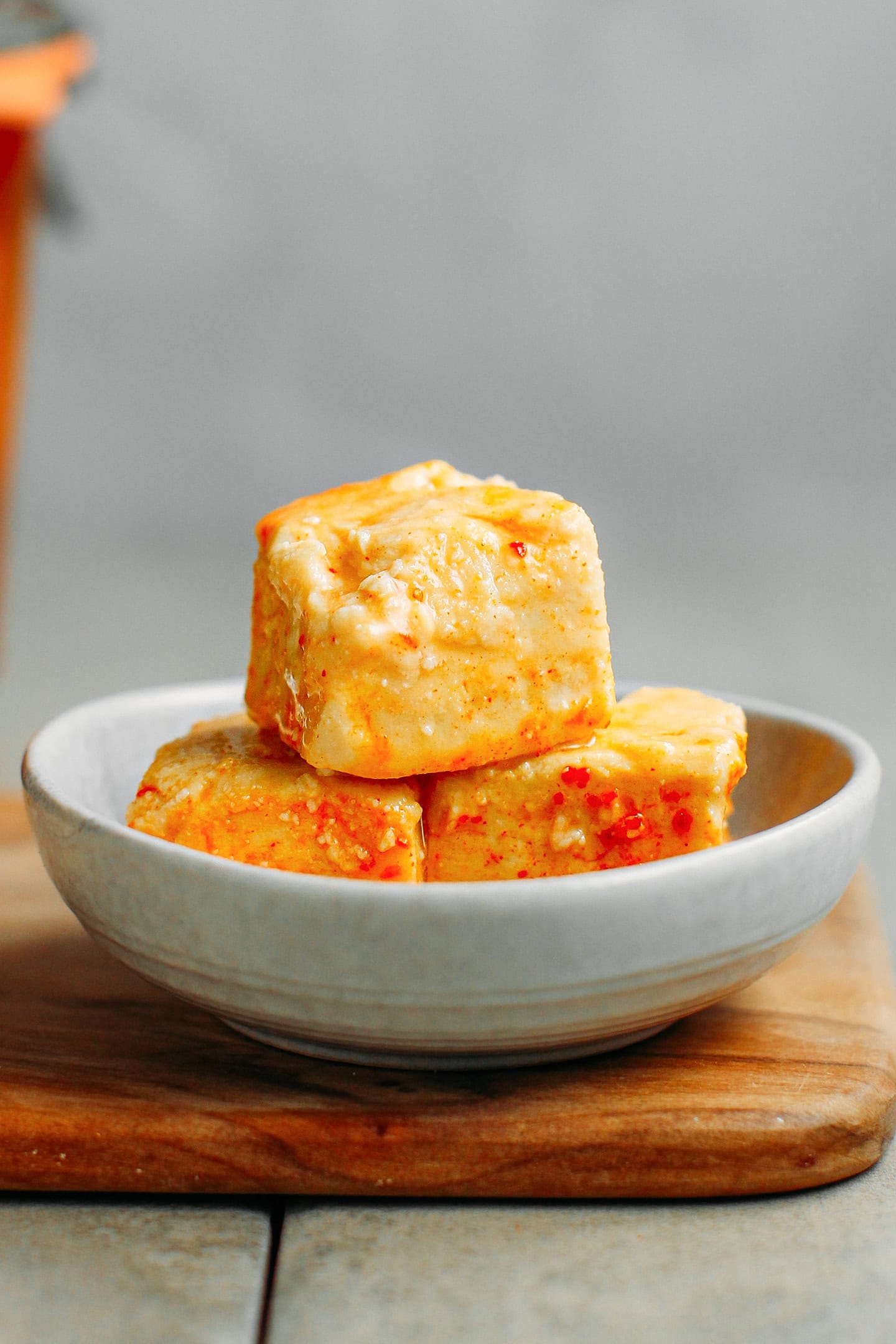
❄️ Storing
- To store: You can easily keep it in the refrigerator for over one year.
💬 FAQ
I do not recommend omitting the wine as it helps preserve the tofu.
No, you shouldn’t have any black mold. If that is the case, start again and make sure all of your tools and plates are clean. Use very clean hands while handling the tofu, or handle it with gloves or clean chopsticks.
The orange mold that grows on the tofu is usually a bit slimy, so that is totally normal.
My guess is that your tofu was softer than the one I used. Hence, it disintegrated and made the brine cloudy. I would recommend trying with another brand of tofu.
No, Shaoxing wine does not work (this one is salty and used for cooking).
There is no need for any starter culture here!
Your chao is ready once it has the texture of blue cheese. It should be very soft and creamy and have a cheesy, slightly tangy taste.
I hope you enjoyed this guide on how to make fermented tofu at home! It’s much easier than it may sound, and it’s a super fun process to see bland tofu transform into creamy and cheesy cubes!
🥡 More Asian Condiments
⭐️ Did you like this recipe? Let us know in the comments below, and tag us on Facebook, Instagram, or Pinterest!


Save this recipe!
Enter your email below and I’ll send it to your inbox!
Plus, you will receive new recipes every week!
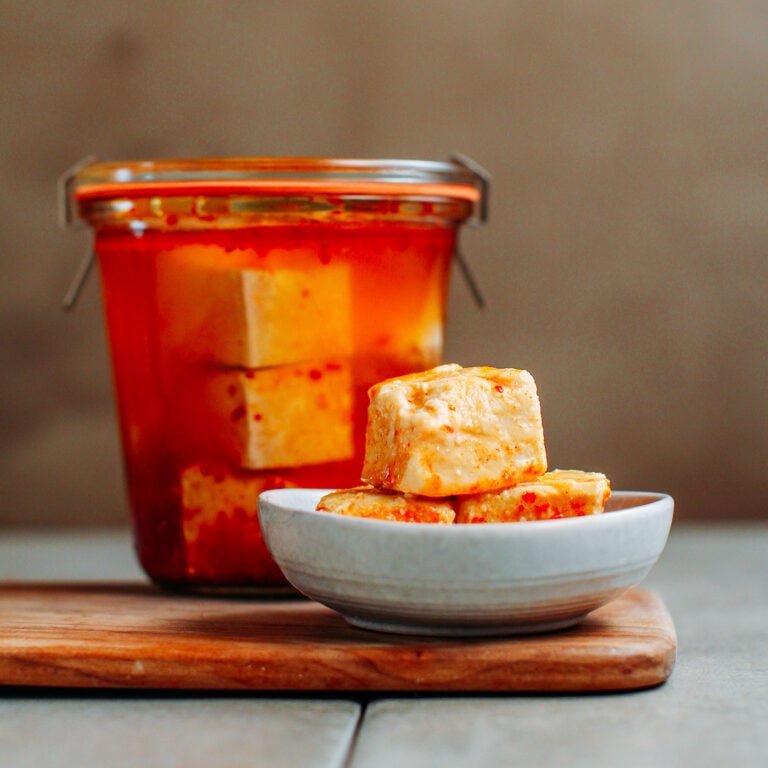
How to Make Fermented Tofu (Chao)
Ingredients
- 1 pound (500 g) firm tofu cut in half
- 4 cups (945 ml) water
- 1 tbsp (17 g) salt
- 1/4 cup chili flakes optional
Brine
- 1 and 1/2 cup (375 ml) water
- 3 tbsp (51 g) salt
- 1 tbsp (12 g) sugar
- 1/4 cup (45 ml) vodka (or 1/2 cup rice wine)
Instructions
- Before starting: As with most fermented recipes, taking care of hygiene is critical to the success of the fermentation process. That’s why I recommend using gloves while handling the tofu to prevent bad bacteria.
- Boil the tofu. In a medium-sized saucepan, bring 4 cups of water with one tablespoon of salt to a boil. Once boiling, add the tofu and boil for 4 minutes.
- Press it. Remove the tofu from the water and place it on a few sheets of kitchen paper towels. Top with more kitchen paper towels and place a heavy weight on it to press the tofu and remove excess water. I usually use an iron skillet. Let it drain for about 90 minutes, changing the paper towel as needed if it becomes too wet.
- Line a plate. Line a large plate with two layers of kitchen paper towels.
- Dice the tofu. Cut the tofu into 1-inch (2.5 cm) cubes and place them inside the plate, leaving about 1 inch between each cube, so they don't touch each other.
- Cover. Top the tofu with another sheet of kitchen paper towel and cover the whole plate with plastic film. The plastic film will prevent bad bacteria from reaching the tofu.
- Let the tofu ferment. Place the plate in a dark place at 77-86°F (25-30°C) and allow the tofu to ferment for 2 to 3 days. The tofu is ready once it has taken on a light orange color and has a stinky smell. You may also see some white mold, which is okay. If you see blue or dark mold, just scrape it off.
- Prepare the brine. Combine 1 and 1/2 cups of water with the salt and sugar in a medium saucepan. Bring to a boil and boil for 1 minute. Once boiling, remove from the heat and let it cool completely. Once cool, add the vodka and stir to combine.
- Coat the tofu with chili flakes (Optional). You can dip each tofu cube in chili flakes. It makes the chao more flavorful and gives it an appealing orange color.
- Add the tofu to the brine. Transfer the stinky tofu cubes to clean glass jars. Pour the brine into the jars to cover the tofu.
- Let it ferment. Close the jars with a lid and place them in a cool, dark place (around 68°F – 20°C) for at least 3 weeks. The longer you let it age, the stronger and softer your tofu will be. I found that after 6 weeks, the tofu was already creamy and had a nice cheese flavor.You can easily keep chao in the refrigerator for over one year.
- Use this fermented tofu to make dipping sauces, top rice, add to vegan cheeses, and use in marinades, soups, etc.
Notes
Use clean utensils.
Make sure all of your tools and equipment are thoroughly cleaned to avoid the growth of harmful mold. This includes your knife, plate, kitchen paper towels, and your hands.Don’t skip boiling the tofu.
Boiling the tofu for a few minutes helps remove excess moisture from the tofu and can prevent bad mold from growing during the incubation step.Watch for signs of bad mold on your tofu.
If you notice black or blue mold, use a knife to scrape it off. However, if there are too many black spots, your tofu is likely spoiled, and you should discard it. Small white mold spots are usually acceptable as long as there aren’t too many around.
About the Author
Thomas Pagot is the founder, photographer, and recipe developer behind Full of Plants. He created the blog in 2016 as a personal cookbook for vegan recipes. Through years of recipe development, Thomas has successfully grown Full of Plants into a trusted resource for plant-based recipes.


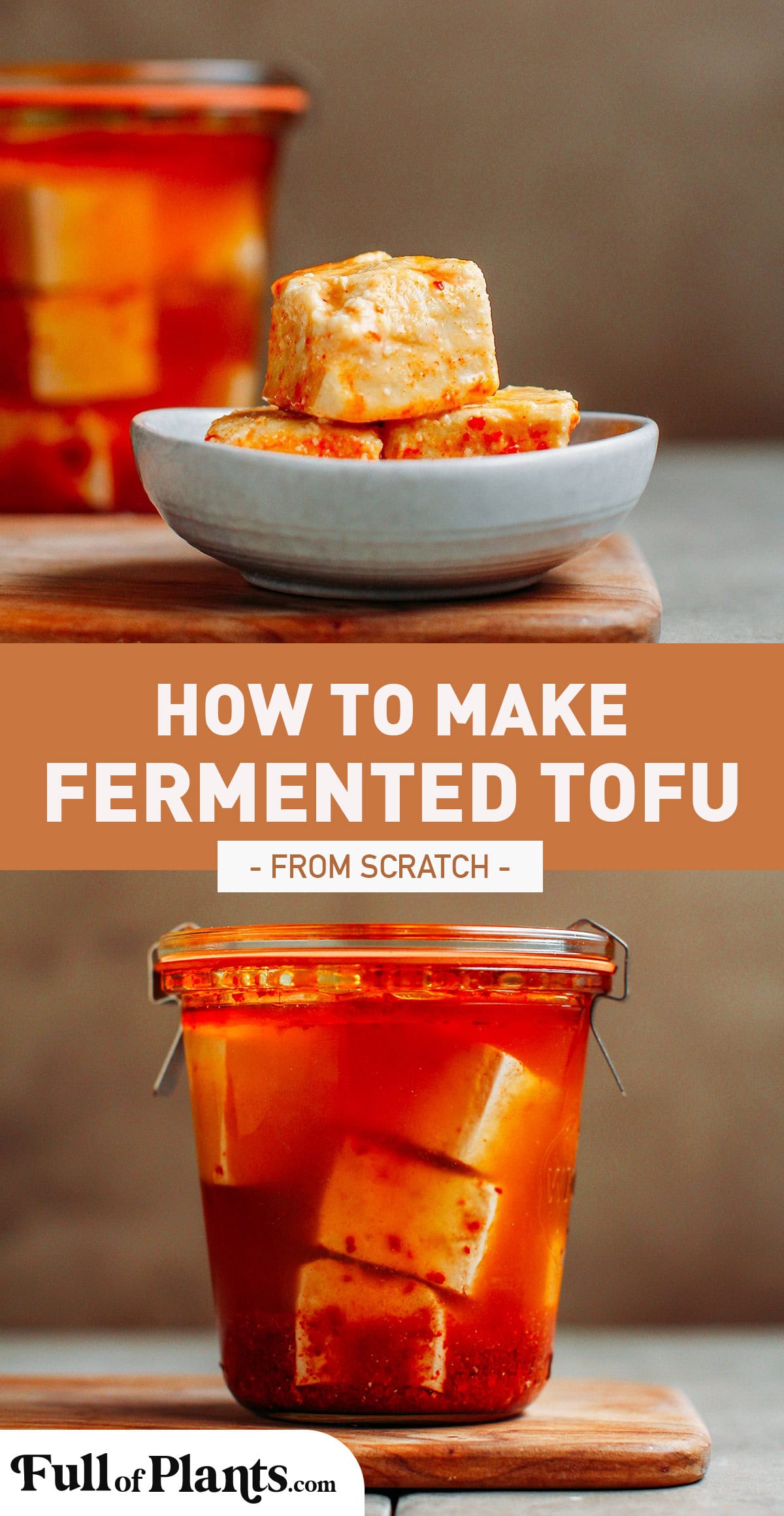
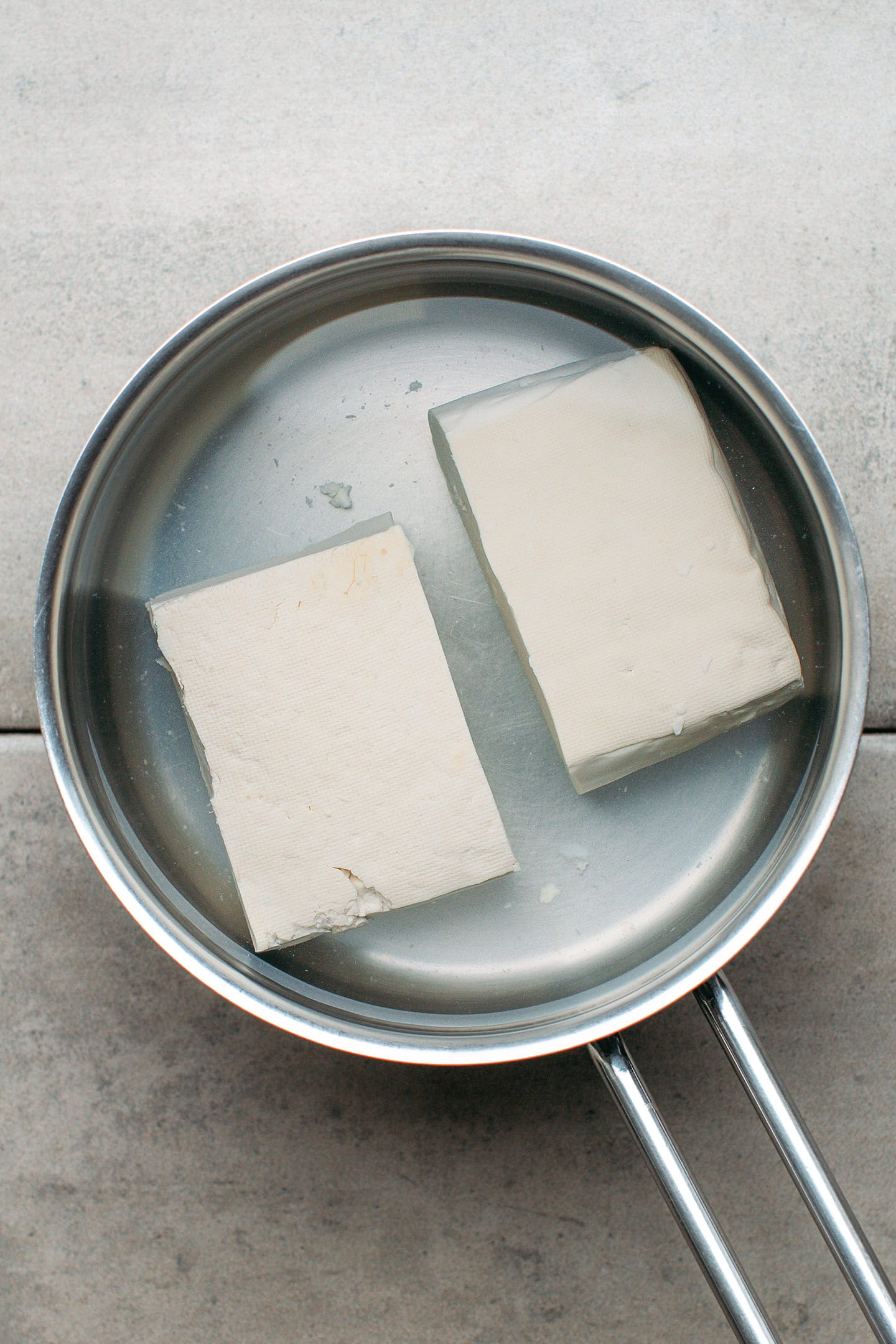
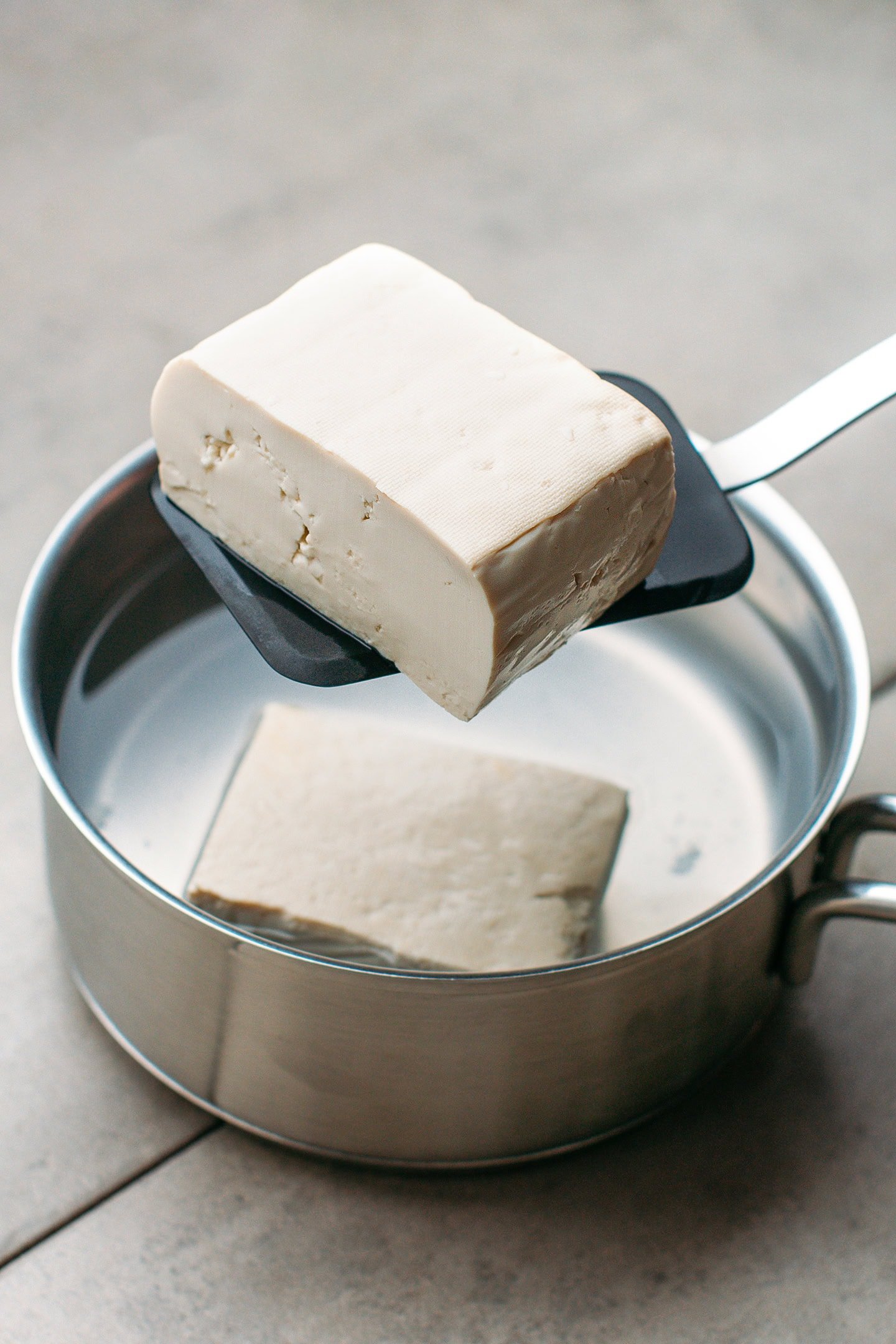
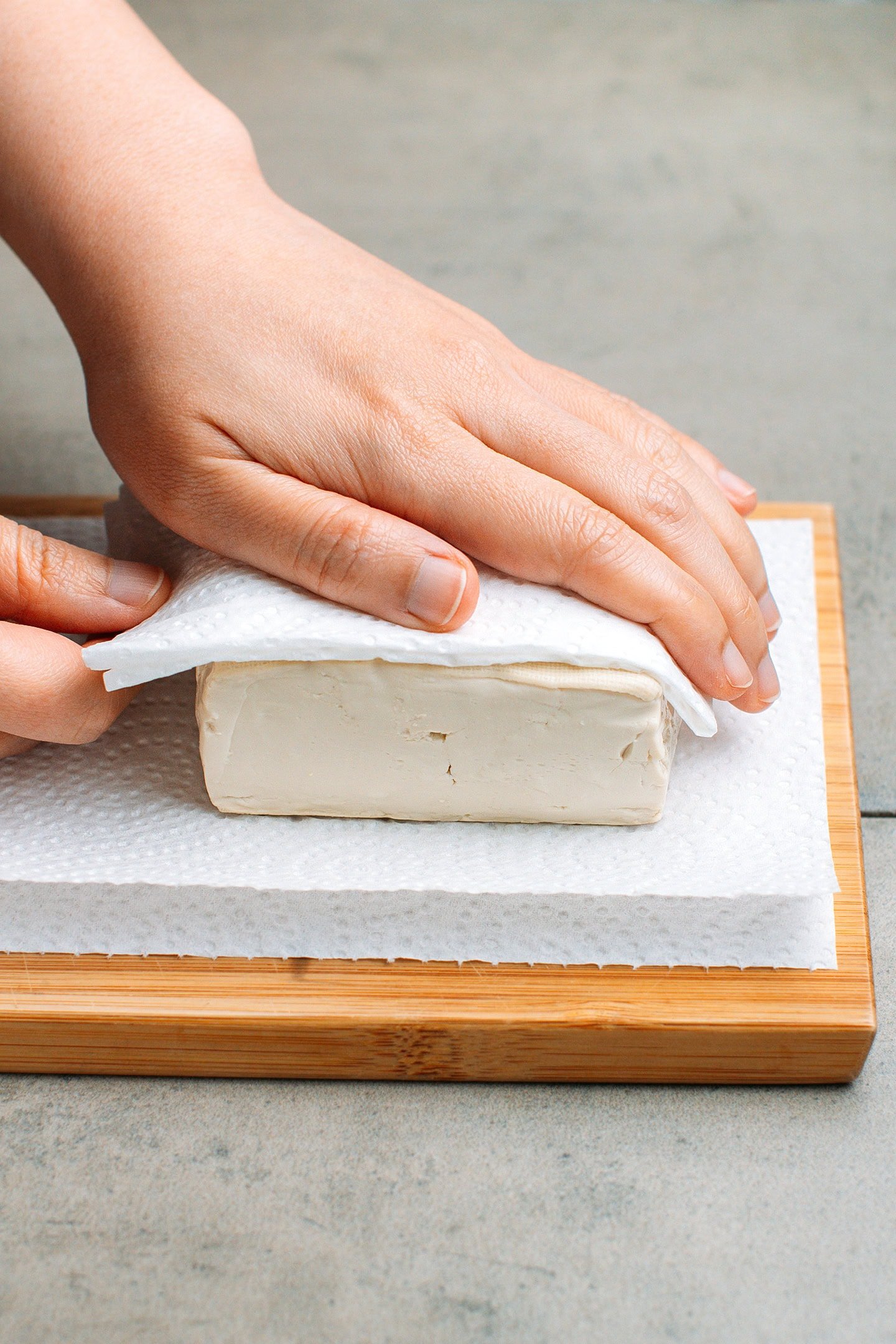
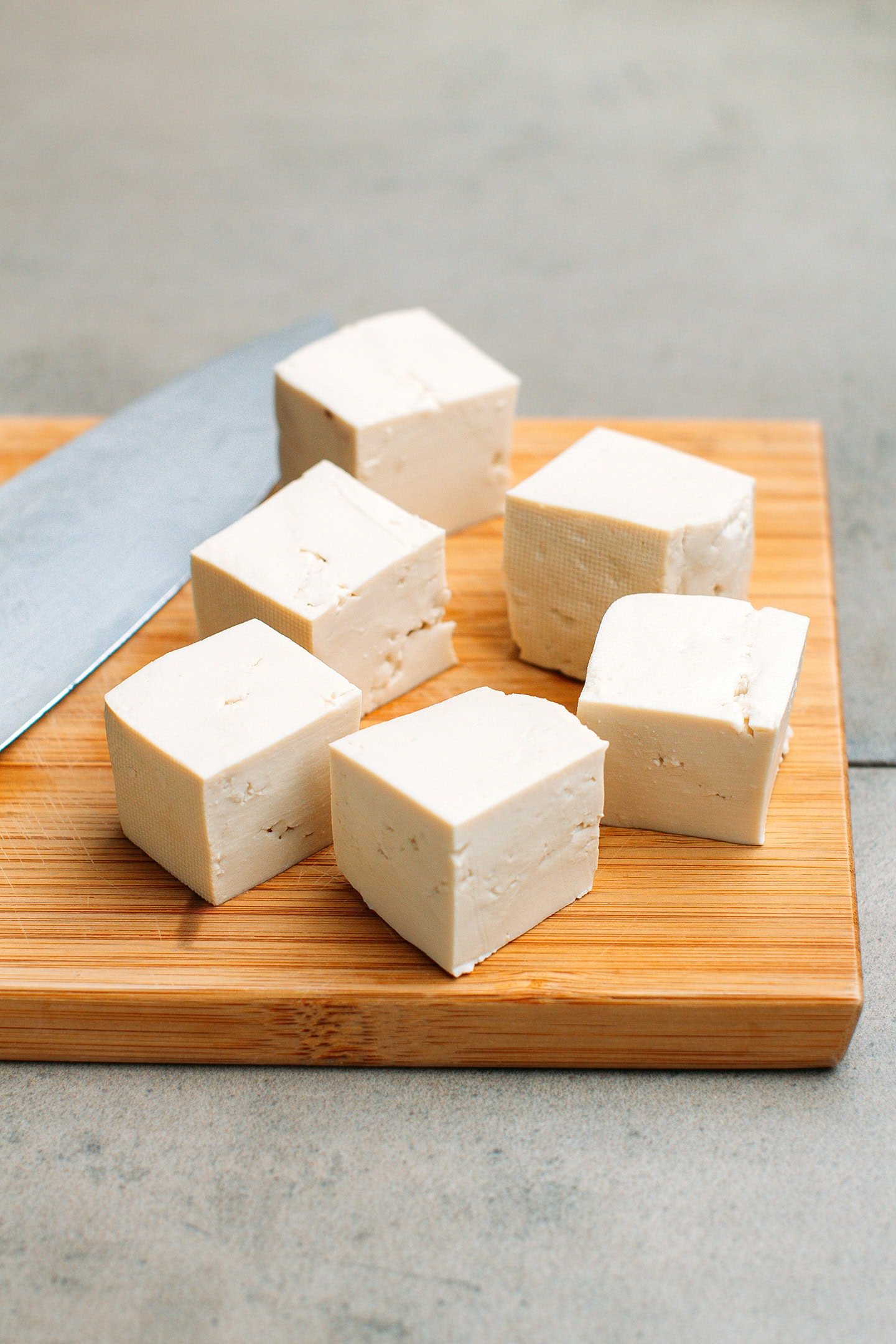



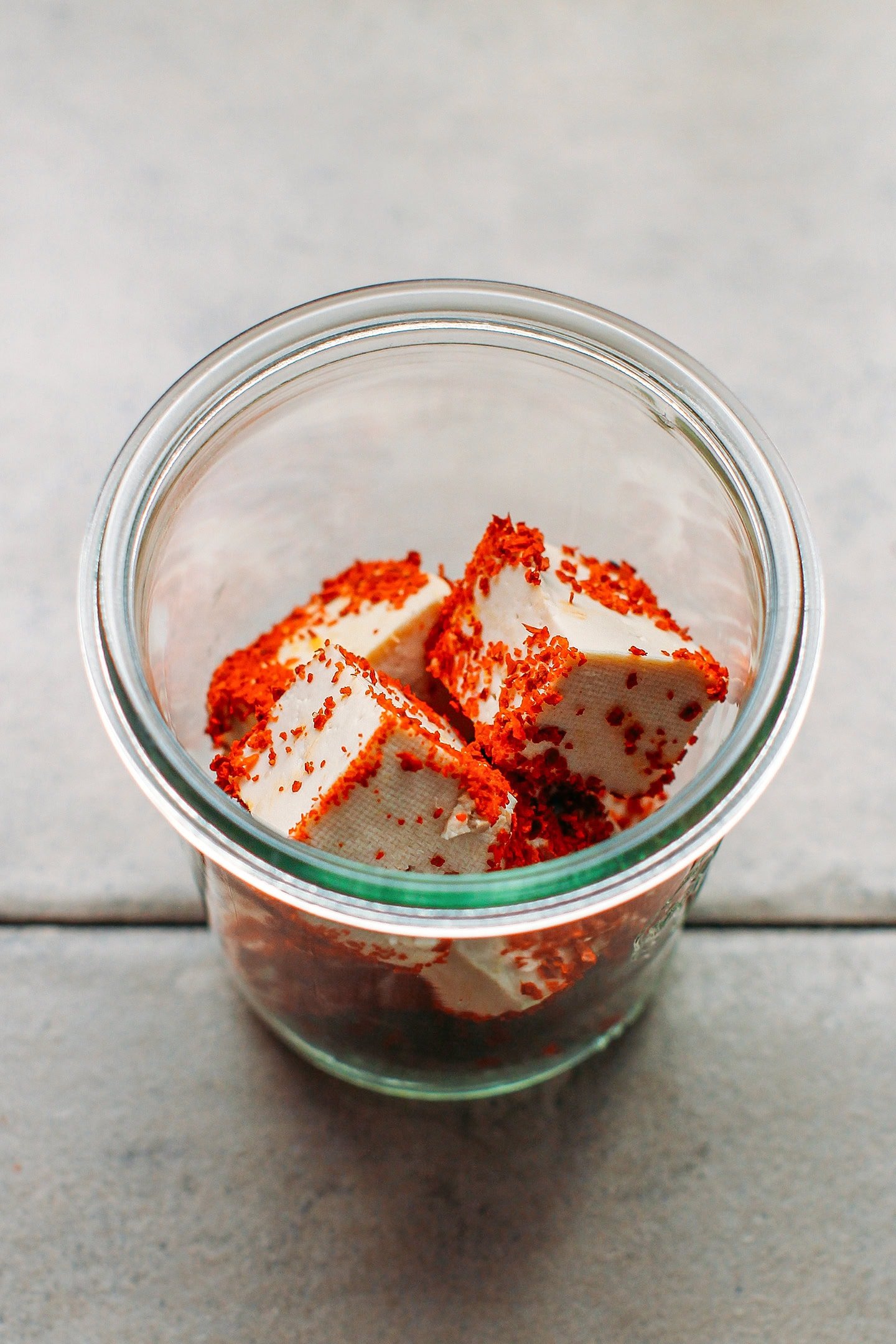
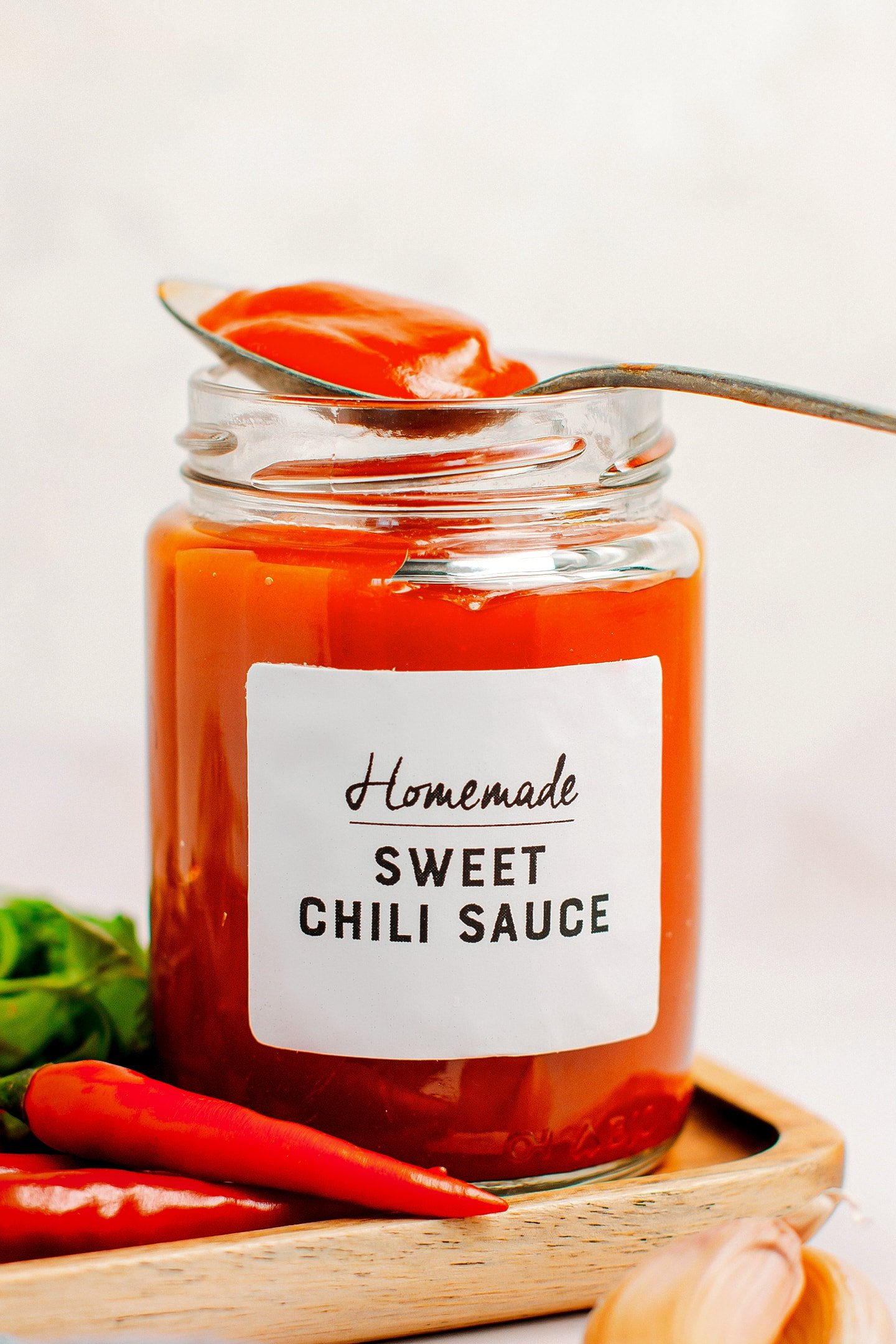

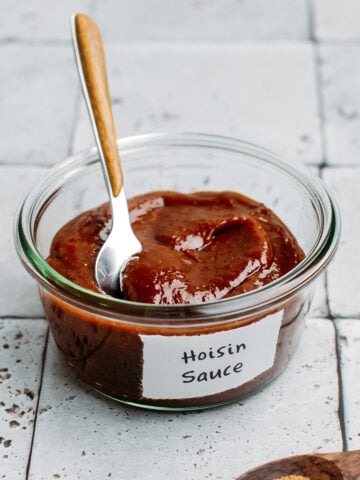
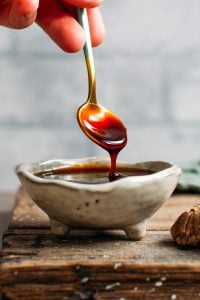
Leave a Comment
I’ve made this many times and it’s come out perfect each time. Tasted even better than the store-bought ones around here. Such a great recipe! And you just saved me a ton of money.
Thank you so much for your great feedback Vanessa!
Hi I will definitely try this! What kind of sugar am I use, the refined white or is brown sugar alright? Thank you. And how about the salt, is regular table sea salt from the market alright? Thank you very much for this recipe, I am excited to try this! It’s my first time to make fermented tofu.
Hi Lourdes,
I have never tried with brown sugar but I don’t see why it wouldn’t work.
Yes, regular table salt works great!
I wish you success with this recipe 🙂
Thank you. I finally tried it. It’s my second day and I did not see any orange spots, but still all white. I will let it stay for another day coz you said 2-3 days. My question is if I don’t see orange spots by tomorrow, should I still put them in jar with the brine? or should I wait until it has orange spots? What if orange spots do not appear? I’m thinking what if the tofu I bought from a supermarket (masoya brand) was coagulated by vinegar that’s why it continues to be preserved? Coz isn’t it tofu uses acid coagulator. The ingredients in the package says- water, soya beans, solidifying agent. Let’s see tomorrow. But I am not sure what to do next if orange spots do not appear. Thank you once again!
So it did not have any orange spots even at third day. I read the comments below and you mentioned to somebody that it should have those orange spots to have the right texture later on. I will wait then. I transferred it inside the oven maybe it needs warmer spot.
I doubt the tofu you bought was coagulated with vinegar, that’s not very common for commercial brands.
I would recommend starting again and this time placing your plate containing the tofu in a warmer spot, the temperature in your home might be a bit too cold for the tofu to ferment correctly.
I made a batch last month according to the recipe and it worked perfectly. I tasted it 3 weeks after brining as recommended, and it tasted exactly like the store-bought product.
I do not have vodka, so I used a brandy that is 30 ABV as a substitute, and that worked fine.
As per the recipe, I used chili flakes, but strange to relate, all the flakes seemingly disappeared after brining. The spiciness still remains though so all is good.
Thank you very much for introducing this excellent recipe.
I’m so glad to hear you had success with this recipe, Adrian!
Thanks for your feedback and rating, I really appreciate it 🙂
I have made this. I got the desired orange hue to the tofu and there is no unwanted black mold. However, my brine has turned cloudy, as if the tofu has degraded. I opened the jar and it smells great. The tofu is very soft and does look as if it’s degraded somewhat. I did taste a bit and it tastes great. Your brine is clear and beautiful. What might have I done wrong? Thank You!
My guess is that your tofu was softer than the one I used, hence it disintegrate and made the brine cloudy. I would recommend trying with another brand of tofu.
Hello! I am ready to brine the tofu. It is orangish and stinky. No black molds.. But it is rather slimy to the touch. Is this ok? Also, is iodized salt ok and regular drinking water rather than distilled. When I make cheese (non-vegan), I know we have to use non-iodized salt and distilled water. Just checking if this is the same. Thank You!
Hello,
I’m sorry for the late reply! Yes, the tofu is supposed to be orange and quite slimy, that is totally normal.
You can use boiled water that you let cool down to prevent bad bacteria, but even if regular water it shouldn’t be a problem due to the high salt concentration.
What are the recommended ways to get a location for the tofu at 77-86 fahrenheit for 2-3 days if it’s winter or you don’t have a warm spot in the house?
Well, if it’s Winter then it’s a bit harder to make, but you should most probably have a warm place where you can put the tofu. For example near an electric heater or radiator.
Hi! I’ve made this once, and it turned out perfect. I just finished my second batch, and I have a question. There’s no mold, dark or white, but there are a few slimy spots. I scraped them off. Just wondering if that’s OK. Thanks 🙏
Hi!
I’ve made this once and it turned out perfect. I just finished my second batch and I have a question. There’s no dark mold but the tofu does have a few slimy spots. Is that OK? I love fermented tofu I eat it every day 🙏
Hi David,
Slimy spots can happen, actually the orange mold that grows is usually a bit slimy.
Do you scrape off the white mold or just leave it before seasoning and putting in jars?
Scrape it off.
Hi Thomas,
I made this on Friday night and had to leave it up to total 64 hours with temperature surrounding 72.5 F (22.5 C) because when it has passed 48 hrs mark I could not see orange specks although aroma of the tofu is already cheesy. However, I checked after 64 hrs and tofu was extra slimy, still smelled clean and cheesy. But instead of orange specks more like smudged pinkish, grey-ish, with orange tinge. Texture is soft like cream cheese when I poked with chop sticks. But I read some of your replies on comments regarding the colour to expect so I threw it in the garbage *sad*. Is it normal for the kitchen towel to be soaking wet? Should it be replaced say after 24 hours? I also I placed the covered plate inside a big pan with glass lid on that has a hole, and inside a cupboard just to make the environment warmer. Could this be the issues?
Hi Maple,
The kitchen paper towels should not be wet. So I recommend replacing them if that’s the case.
I also believe keeping it inside another pan may have kept more humidity than needed, which may have allowed different mold to grow.
A few spots of white or light grey mold is okay, just scrape it off. However pink or black mold is not good. Hope you will have success next time!
Hi Thomas
Could I use dark rice wine or only the white one to make the Chao? I’m looking forward to making the cheese.
Hi Jaslyn,
I guess dark rice wine might work as well but I haven’t tried it so I cannot say for sure.
Will it still turn out if you didn’t boil tofu first? It looks like the color and very gooey.
I’m not sure to understand your question Sarah.
Hello
I want to ask you about the microbiological fermentation cultural in making tofu
Do you start with the mold strain Antinnormucor elegan? or other?
IF you know about starter mold for fermented tofu and where it to buy . Please, talk and share with me
thank you
Hello Nhon,
As you can see in the recipe, I do not use any mold or starter.
Hi! I looked through comments to check if someone had already asked – can I clarify you mean rice wine like shaoxing Chinese rice wine? Is there another kind you recommend? Not rice wine vinegar correct?
Thank you!
Hi Julia,
No, not Shaoxing wine (this one is salty and used for cooking). I mean regular rice wine or vodka. Basically, any neutral alcohol.
Hi, it’s Ellie again with another question. The fermenting seemed to go well, but there were lots of spongy-looking light brown areas in addition to the orange mold and a few spots of dark mold that I removed. The smell was right. Do you know what the spongy-looking areas are? Is it another kind of mold? Do you think it will be okay?
You should get some orange spots, a few white spots of molds, and it’s possible that very small spots of black mold appear (which needs to be removed).
But to be honest, I am not sure what is that spongy-looking mold you have. Black mold is usually not good.
I went ahead with the brining two years ago in spite of the spongy-looking areas and it came out fine. I’m making it again now (with similar results), so I’m reading the comments again and noticed this. The spongy-looking areas are beige and aren’t actually spongy, when I touch them with a chopstick they are slimy. Thanks again for this great recipe!
Happy to hear you had success Ellie!
Dear Thomas, thank you for all the great recipes. As I was reading all of the comments on fermenting of tofu there was a few things missing that I remind all new fermenters to keep in mind and practice. I learned a lot from a friend of mine who has been making goat cheeses for years. She knows all of the different Bacterias by name. I have been fermenting all types of veggies for years and what I learned is that the salty brine in meant to kill and protect the veggies unwanted bacteria. I think the most important factors are for success is to keep things clean possible, make sure your veggie is totally submerged below the brine throughout the fermenting process (if you use canning jars to do the ferment you can buy glass weights to wait your veggies down so they stay below the liquid level), also the fermentation process creates gases that need to escape without letting into jar any outside air, perfect temp is around 68°during the process and it is best to keep them in the dark while fermenting. I tell all my friends about your website, thank you again for all the great work you do.
You’re welcome Kit!
Yes, you are right, all tools and equipment used must be super clean to prevent bad mold from growing.
Hi Thomas, thanks for all the great recipes 🙂
Today I came to your blog in the hope that I would find a recipe on how to make ‘hairy tofu’. If I’m trying any new fermentations, I first check if you have a recipe. After that, I tried searching the web, but I was also left empty-handed. Since this seems like a thing that is right up your ally (it is fermented, it is tofu, it is cheese-like), I thought why not give you a shout 🙂
Have you already had some experience in making it, and do you maybe plan to make a recipe about it?
Sorry for highjacking this recipe, but I did not know what is a proper way to ask, hope you don’t mind
Hi Nikola,
You are welcome! I tried stinky tofu before, but it’s the first time I hear about hairy tofu, it looks interesting! 🙂
I will definitely look into it. It seems the mold comes from straw, so maybe you should look into natto mold, although I am not sure if it is the same mold yet.
Thanks, I will keep digging 🙂
I found something 😀
https://www.reddit.com/r/fermentation/comments/v8i4ww/comment/ibsghpo/?utm_source=share&utm_medium=web2x&context=3
it is mucor powder
it is hard to come by, but I found this store (DISCLAIMER: I don’t know if it is legit yet):
https://www.ebuy7.com/item/542104441793
I used this recipe as a base for making Chinese red bean curd, which goes for $12.99 for a 9oz jar online; it is used for making barbecue marinades for things like Char Siu and Chinese spare ribs.
For those who follow this recipe and get bad results, keep in mind not all tofu are created equal. I used good quality organic, and got the correct results on the first try. Most cheap tofu are not meant for fermenting, in my opinion.
Another note -fermented tofu gives off ammonia compounds, hence the strong smell of ammonia. Those that claim their finished tofu smell of rotten eggs or dirty socks…you need to wonder. Cheers !
Thanks for sharing Charlie!
And thank you, Thomas ! I’m off to save a lot of money thanks to you.
After boiling in salt water and pressing the tofu I let it sit covered but it got very dry and hard around the edges and didn’t grow mold after 2 days. Is it supposed to get so hard? I’m not sure what I did wrong.
No it’s not supposed to turn hard or dry. I would recommend trying with a softer tofu, or pressing it for a shorter amount of time.
I am interested in making this but adding some red yeast rice powder. Have you done this? How much should I add?
I have never tried adding using yeast, why would you want to do that?
It works very well without the addition of any yeast or cultures.
Hi Thomas.
I love your recipes. I’ve made a few of the vegan cheeses, and they have been great.
I’m having trouble with making chao. The tofu cubes do not go moldy; they only dry out. The tofu become hard, brown cubes. I’ve tried two different types, and firmness of tofu.
Any suggestions?
Thank you!
Hi Marion,
Thanks for your feedback!
Have you tried using medium tofu? Medium tofu has enough moisture to prevent it from drying completely. Also, try placing the tofu in a warmer room, it should help with mold growth.
Thank you so much for your help and wonderful recipes.
You’re welcome Kathryn!
Hi Thomas
If I half this recipe and I use rice wine how much do I need I am in UK and don’t do cups and as the amount doesn’t change if I go to metric I’m not sure the amount I need to use any help would be appreciated
Hi Kathryn,
If making half, you would use 60ml of rice wine.
Can you tell me how many millilitres is half cup please?
120ml.
Hi Thomas, first I would like to thank you for sharing your recipes. The sauces are the most amazing sauces and I make many of them already. I have also been making your miso with chick peas, and I tried the fermented tofu. But, is it really supposed to smell bad?? After a couple of weeks, it was so awful I threw it away! I think I may need to buy some ready made fermented tofu first, to get a “feel” for what it should be like. My friend, Helen, is addicted to your chick pea miso, and has now started to make her own supply! thanks again, hope you are safe and well in these difficult times, Gay
Hi Gay,
Thank you so much! 🙂
Regarding the fermented tofu, it shouldn’t smell bad at all. It should have a cheesy smell/flavor. Yes, buy a jar so you can compare and make sure yours is not turning bad.
I’m glad your friend likes the chickpea miso, it takes a long time to be ready, but it’s definitely worth it!
I’ve tried three times to make this and each time my tofu has gone mouldy. I have been very careful about hygiene but the last time I tried to do it it ended up covered in a fluffy grey mould, like a dandelion seed head. Unfortunately I don’t seem to be able to attach a photo here. Where am I going wrong.
It’s very hard to say what is going wrong…Do you keep the tofu cubes on a plate lined with a kitchen paper towel, topped with more towel and wrapped in plastic film?
Maybe try another brand of tofu as well.
Hello, I really enjoyed following this recipe’s method, but I found at the other end that I had more of a creamy tofu mess than the clear(ish) red liquid you see to have. I’ve just bought some Chao for the first time so I know what it’s supposed to be like, but do you have any idea where I might have gone wrong?
All the best.
Lily
Hi,
Did you stir it regularly? Were the tofu cubes packed tightly? These could be the reason you didn’t get a “clear” liquid. If you stir it or pack it too much the tofu will slightly disintegrate and make the liquid more cloudy.
Hi, thank you for this recipe, and for answering questions in the comments. How important do you think it is to have the right temperature for the second fermentation stage, when you want it to be cool? Is it going to fail miserably if the ambient temperature is 80F?
Hi Ellie,
The second fermentation stage, in the brine, is not that important. 80°F is totally okay. This recipe is Vietnamese-inspired, and it is much warmer there, yet they keep the jars at room temperature, so don’t worry too much about it.
That’s great! Thank you. I’ll let you know how it goes.
It worked! The house probably varied between 70 and 95 deg F during the three weeks it was fermenting, and it seems to have worked fine, and it tastes recognizably like ferment tofu (I’m more familiar with the Chinese version than chao). My only complaint is that it actually tastes a little bit like vodka. I halved the recipe but used a jar with extra room, meaning the cubes are kind of swimming in the brine. Maybe that was the problem?
I like it but my boyfriend hated it–we can both taste the vodka taste but I don’t mind it as much. Next time I might try using rice wine.
Awesome!! Regarding the vodka, I’m surprised as I cannot taste it at all. Once fermented, the “stinky” smell and flavor completely covers it usually. Maybe try a different brand of vodka, or another alcohol like rice wine as you said. Well, Chao definitely has an acquired taste and it’s not everyone’s cup of tea 🙂
Hi Thomas, I’m making this again. I hope it works as well as last time. I want to use a different alcohol this time. What kind of rice wine would I be looking for — the low ABV cooking wine or higher ABV sake? I’m having trouble finding kosher-certified cooking rice wine, so I may try vodka again. Do you think it would work if I used less vodka, e.g. 1/8 cup instead of 1/4 cup?
Thanks again for the recipe and your generous advice!
Hi Ellie,
I have never tried reducing the amount of vodka so I cannot tell for sure, but the brine is already pretty salted so I am guessing it would still work.
Regarding the rice wine, I would recommend a higher ABV sake.
Hi, I made this event though I had no idea what to expect. I tried it today for the first time and it has blown my mind! It reminded me a little of feta cheese (my husband – non vegan, disagrees!)
I sprinkled it on my salad for lunch- amazing!
I am now wondering if I can use other ingredients in the jar to give it other flavours?, the chilly is very prevalent but just right.
Is there anything else you would recommend I can add?
Thank you so much, for the first time I can say tofu had flavour!
Hi Eleonora,
Thanks for your feedback! To be honest, Chao is not usually flavored with anything else. However, I believe adding some smoked paprika would make a nice addition to the cheesy flavor.
Thanks for the recipe and guide!
In the first fermentation, where do the microorganisms to do the fermenting come from? If you’re very careful with your technique, the boiling ought to kill anything that’s in the tofu and then it’s all sealed up in paper towels and plastic wrap.
Are we counting on a few bacteria and mould spores that fall in while we’re processing it? Or maybe bacteria and spores from the paper towels?
Sorry for the geek question. I have a microbiology background!
Thanks!
Hi Andy,
I would not say it’s completely sealed, there is still air inside. I do not have a microbiology background, so I can’t answer your question in depth, but I can say that it works 🙂
top top